Apple's iPhone 4: Thoroughly Reviewed
by Brian Klug & Anand Lal Shimpi on June 30, 2010 4:06 AM EST- Posted in
- Smartphones
- Apple
- iPhone 4
- Gadgets
- Mobile
FaceTime
Meet Manveer. I’ve known him since I was in the 6th grade. Somewhere around the 8th grade we started a ritual of calling each other every day after school and talking about video games, computers and dumb things that happened at school. We talked on the phone for hours. Back in those days we would even play the same game on separate computers while talking on the phone. It was a precursor to voice chat in gaming networks like Steam or Xbox Live. It was ridiculous amounts of fun.
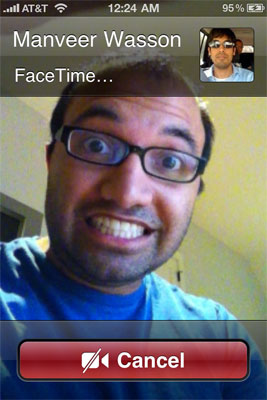
Manveer is up in the corner, the crazy guy is yours truly
Tonight Manveer and I FaceTimed. It’s the feature I wish we had when we were back in middle school. These days it’s a lot harder to explain why you’ve got some random dude’s face on your phone talking to you about completely pointless things at 12:54AM on a Tuesday night. I spent part of the chat covering one of the lights in my room with my head and calling it an Anand Head Eclipse. At the risk of further embarrassing myself publicly, it was fun.
For those of you who don’t know, FaceTime is Apple’s VoIP protocol built into the iPhone 4.
Granted we’ve been able to do this sort of thing for quite a while now over instant messenger networks. Integration into your smartphone is just the next logical step, and in the right conditions it works very well.
 |
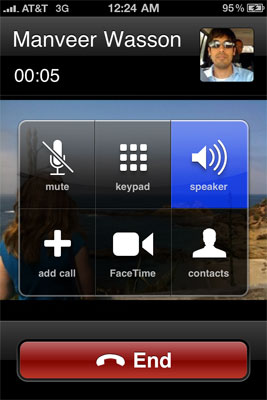 |
The first requirement is that both users need to have an iPhone 4 obviously. Both also need to be on WiFi. While the FaceTime icon will appear if you call another iPhone 4, if you try to activate the connection you’ll get this error unless you’re on WiFi:
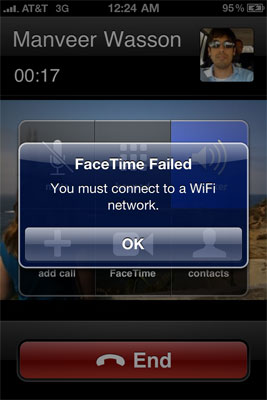
With a bit of poor UI design Apple will actually display a FaceTime icon with a question mark in it if you call another iOS phone. Trying to activate FaceTime however gives you an error.
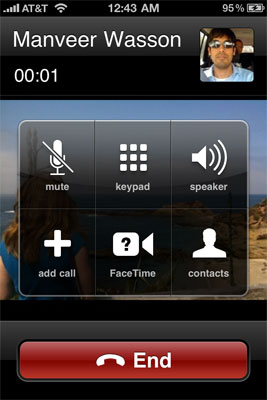 |
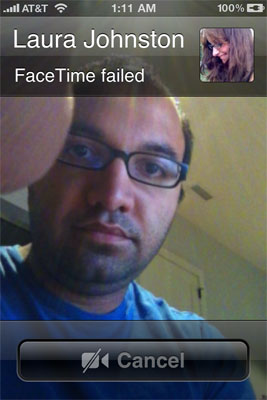 |
FaceTime requires roughly 100 - 150Kbps of bandwidth in both directions to work smoothly. The download should be fine but the upload is pretty high given that many broadband providers in the US are ridiculously stingy with their upload bandwidth. For FaceTime to work well you can’t be uploading or downloading anything large in the background, or if you are just throttle everything else to give you enough bandwidth to work with.
The next problem with FaceTime is the iPhone 4 lacks an absolutely necessary integrated stand. HTC got it perfect with the EVO 4G, unfortunately the 4 has no such thing. The closest you can get is Apple’s iPhone 4 dock, it’ll set you back $29 but it’s necessary to prevent you from getting tired holding your phone out in front of you. Laying the 4 down on your desk while you FaceTime just gives the person on the other end of the line a great view of your nostrils. Not very welcoming.
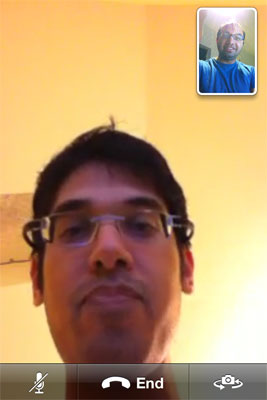
This is the on-table view of FaceTime, you need a stand
Even once you’ve met all of the requirements it’s still not a guaranteed thing. Even with ample bandwidth I had one FaceTime chat stall in the middle of the chat. My incoming feed froze and I had to wait a couple of seconds for it to resume. I also had a problem where FaceTime would fail to start on the first try. A subsequent try fixed it.
As you'll see in our camera investigation, the low light performance of the 4's front facing camera is horrid. Couple that with FaceTime and you will get bad image quality if you're not in a well lit room:

Ugh, what is this, 1998?
While in FaceTime you can easily switch between front and rear cameras by tapping the camera icon in the lower right corner. Unfortunately the compression on the video is enough to render text illegible while in FaceTime:
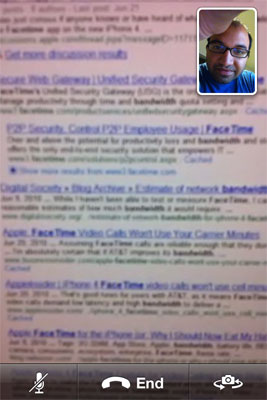
This was taken using the rear facing camera over FT
Obviously everyone knows where FaceTime is going. Apple is supposedly opening the protocol up to all developers, so you’d be able to theoretically build desktop and other smartphone FaceTime clients. And ultimately as mobile broadband speeds (hello WiMAX and LTE) improve the WiFi requirement will be dropped. But is it a good feature today?
It really depends on who you know with an iPhone 4. If you’ve got a Manveer, absolutely - the feature is worth it. If you have a bunch of casual acquaintances with iPhone 4s, probably not. It’s only useful if you know the person on the other side very well.
There is one other major benefit to FaceTime. Once enabled your call is routed over WiFi to the Internet, not AT&T’s 3G network. It doesn’t use any of your plan’s minutes and more importantly, voice quality is much improved over a regular 3G/EDGE phone call. It’s VoIP, not a crappy cell connection. Even if you just cover the camera it’s actually better to make calls over FaceTime than 3G based on the sound quality alone.










270 Comments
View All Comments
Mumrik - Friday, July 2, 2010 - link
Stop that shit. We all know major iPhone (iPod, Windows, Intel CPU etc.) releases matter more for the industry and the majority of people so it is only natural that they put more work into these articles that are going to get more readers. There is one iPhone out there at a time but a gazillion competing Android phones. They can't cover them all like this - that is why they put extra effort into articles that cover Android itself.I say this as someone who has sworn to never own an Apple product.
Henry 3 Dogg - Thursday, July 1, 2010 - link
Re your final comment"Changing the bars visualization may indeed help mask it [the signal drop], and to be fair the phone works fine all the way down to -113 dBm, but it will persist - software updates can change physics as much as they can change hardware design."
From my own tests, I think that you are missing something here.
When you bridge the left corner line and see the signal strength drop, it does so over the course of several seconds. One would tend to assume that this is time averaging in software BUT...
if you make a call in a very weak signal area and then bridge the gap, the call degrades and possibly drops in the same way i.e. over the course of several seconds.
If the whole effect is physics, then the call should degrade instantly - but it doesn't.
Clearly there is a physics effect, but it also appears that the phone software is responding to this physics effect in a manner that makes it more of an issue.
It may/should be possible, by software changes, to make the final signal degradation when the gap is bridged, no more that it is immediately the gap is bridged, and in all honesty that would pretty much close the issue.
Personally I just don't bridge the gap, and then I find, like you did, that I can simply use this phone in places that I've never been able to use a mobile before.
This really is the best phone yet.
John Sawyer - Thursday, July 1, 2010 - link
"It may/should be possible, by software changes, to make the final signal degradation when the gap is bridged, no more that it is immediately the gap is bridged, and in all honesty that would pretty much close the issue."Hopefully this is what Jobs meant when he said, "Stay tuned."
mmike70 - Friday, July 2, 2010 - link
Maybe calls are more forgiving because I haven't had one drop yet. What does happen is when I hold the iphone4 normally in my left hand (I'm right handed, tap with the right hand fingers, hold with the left), the data connection drops immediately. I'm not talking even over the course of five seconds. The currently loading web page will stall the instant I pick the phone up. This is in an area with a very close tower, constant 5 bars on an iphone 4 and 3gs. I can't cradle, grip, pinch, cover, etc the 3gs to make any detectable difference in data performance.chinkgai - Thursday, July 1, 2010 - link
Hey Brian or Anand,Just wanted to point out that on my wireless N/G with the same speedtest.net app tests, my download speed usually always tops out around 10700-11000 kbps, so I'm not sure why you're getting such a low speed on average. It also maxes out my upload speed which is far lower than yours. I'm on a 16/2 line here in Los Angeles.
Great article though!!
bparun - Thursday, July 1, 2010 - link
Obviously a good thorough review. Why is there not a good amount of detail about the newly added Gyroscope in iPhone 4? I have read that its the electronic version of a vibrational one. More on that would be a nice read, as the future of games and apps using this gyroscope for augmented reality would be in abundance. I am sure all the other phone manufacturers are ready to follow, as usual.Mumrik - Friday, July 2, 2010 - link
Such a minor feature in the larger perspective...John Sawyer - Thursday, July 1, 2010 - link
It seems to me, that if the iPhone 4's signal is attenuated when one's hand bridges the gap between the two antennas on the lower left side, but not if one bridges the two antennas by holding the iPhone 4 at its sides, above the gap, that one possible fix for the future, might be to move the gaps so that they're at the topside left and underside left, so one's hand (left or right) doesn't touch the gaps (I doubt many people cover the bottom or top edges of their phones while in use). This would allow the lengths of the two antennas to remain nearly the same, and so it might not compromise the original antenna design's signal strength, unless the original design relies on the upper and lower left corners/ends of the two antennas to be untouched by a user's hand, which would be stupidly unnatural (as nearly everyone notes). If full antenna strength does require these two corners/ends to be uncovered, does this mean the iPhone 4's main radiating signal power, for both antennas, emits from the upper and lower left corners/curved ends of the two antennas, rather than from the entire length of the antennas? If the entire length of both antennas send/receive, moving the gaps to topside left and underside left wouldn't seem to greatly affect the right-side UMTS/GSM antenna's exposure to the world (more critical than the left Bluetooth/wifi/GPS antenna's exposure, since a cell tower is usually further away than a local wireless router, etc.), no matter which hand it's held in (can't say the same for the left-hand antenna, but that may not be important due to closer proximity of wireless routers, etc.); but if the signals for both antennas send/receive mainly from one end of each antenna (currently the curved ends), requiring them to have some uncovered access to the world, then what about moving the gaps closer to the center-top and center-bottom locations? I have a hunch that these potential end-radiating points don't have to be curved, as they currently are at the corners, but maybe I'm wrong. However, this would make both antennas nearly the same length, which might affect signal strength too, if the different frequencies sent/received by the two antennas require their lengths to be as they currently are.
If Apple doesn't want do anything like that (or if the antenna design doesn't allow for it), or even to coat the exposed metal antenna with some kind of clear coat (if that even helps enough), it might be best to move the antennas back inside, wrapped around the inside of the case--I don't think too many users will moan about not being able to touch metal around the sides of the iPhone. Another approach (which would work for either internal or external antennas) might further improve the antenna: two antennas for the phone signal, one at each lower corner (since FCC phone-to-head maximum radio signal level requirements now force manufacturers to put the phone antenna in the bottom of new cellphones), with whichever one that's not covered by the user's hand being used (circuitry in the phone could detect this).
iwod - Thursday, July 1, 2010 - link
1. I dont know why no one mentioned it in their reviews. And only Anand manages to point out my same thoughts, Why no insulation coating on the Stainless steel? It add less then 1mm of thickness and is cheap and easy enough to do so.The only reason would be Apple Engineer were using 3GS casing while they were testing..
2. No one mentioned the new Skyworks Baseband chip. I have never head of them, and dont know how good they are. Wiki shows they have been in the business for nearly a decade now, so that should be good. The Less Drop calls on iPhone 4 were more to do with this Chips instead of AT&T network upgrade. The previous Infineon Chipset were simply poor. It was Infineon first chip into communication and mobile network. And it didn't work well although the problem were easily pointed to AT&T network. It wasn't only AT&T were having drop calls, Every iPhone 3G user in the world were having drop calls with different Network. And the Drop Calls rate for iPhone 3G/3GS on AT&T were much higher then any other phones on AT&T network. That simply points to a problem the lies within iPhone.
3. The iPhone A4 is a package on package SOC. The Memory was Dual Channel Low Power DDR. Why didn't they use Low Power DDR3? It is lower power and faster then ancients DDR.
4. Why didn't Apple upgrade their GPU? The iPhone 4 is 4x as much resolution. Playing Games on it requires much more computational power.
5. 110ppi may not be enough for desktop. But how many ppi would a Retina Display for Desktop and Notebook need? I just measure we are typlically at least 24 inch away from the monitor, double the distance as you would hold on a iPhone. If a iPhone 4 requires 330 ppi, then Double the distance would half the ppi, which means 165ppi, That means 2560 x 1200 Resolution for 18" Display. For a Large Desktop Display 27", you will need 4K ( 4096×1716 ) resolution, which is actually perfect for Digital Film making and Broadcasting. I think it is time we distinguish a Computer Display to Normal TV. They can keep with their 1080P for as long as they want. We want Retina Display on our Mac.
( Notes: However even the lastest DisplayPort 1.2 does not offer enough bandwidth for 4K resolution )
6. Software Side - Some Reports indicate iOS 4.0 uses more memory then older iOS 3.0 which more useless process standby ( Such us Internet tethering and Bluetooth.exe even when both features are OFF ). While they may only consumer 2 - 3MB of memory. It is still a lot on a mobile devices. I hope anand can verify if they have time.
7. Saferi on iOS 4.0 seems to be using a older version of WebKit as well. I am sure SunSpider will run faster and on par with Andriod once Apple update iOS.
brownreese - Thursday, July 1, 2010 - link
I am blown away by the thoughtfulness of this review. Too many sites read like regurgitated press releases. I have just become a lifelong reader. Thanks.